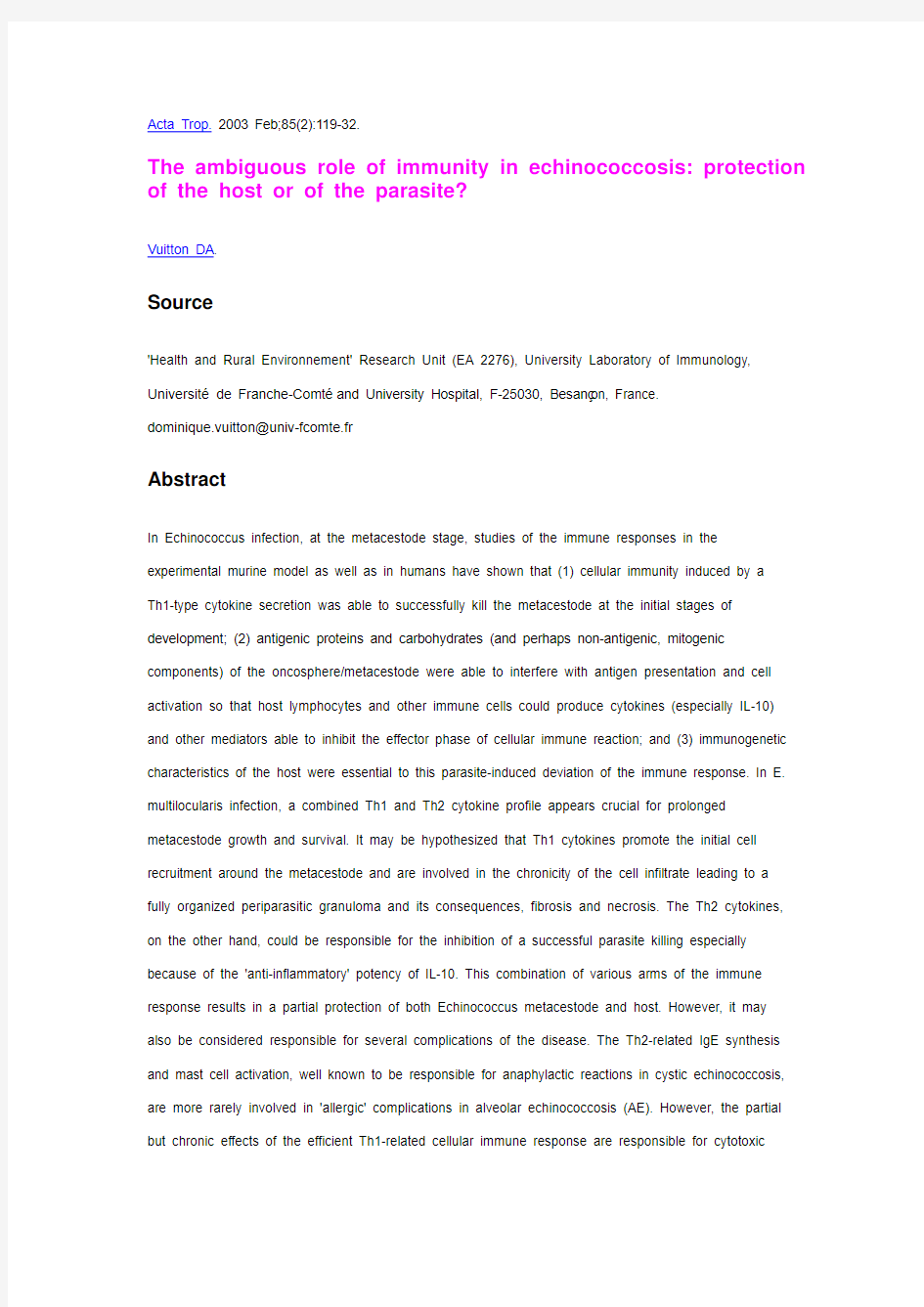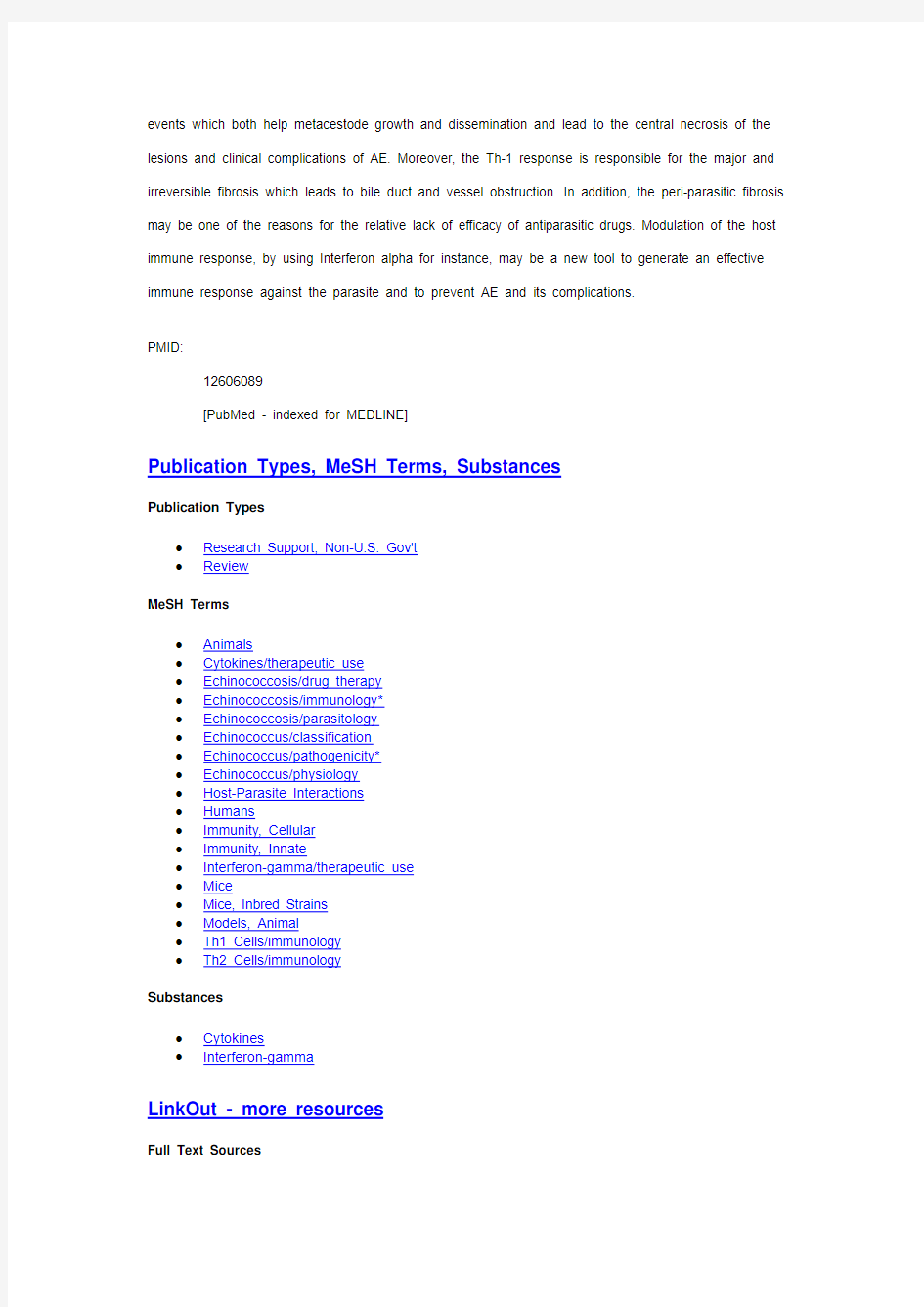baoc


Acta Trop. 2003 Feb;85(2):119-32.
The ambiguous role of immunity in echinococcosis: protection of the host or of the parasite?
Vuitton DA.
Source
'Health and Rural Environnement' Research Unit (EA 2276), University Laboratory of Immunology, Université de Franche-Comté and University Hospital, F-25030, Besan?on, France.
dominique.vuitton@univ-fcomte.fr
Abstract
In Echinococcus infection, at the metacestode stage, studies of the immune responses in the experimental murine model as well as in humans have shown that (1) cellular immunity induced by a
Th1-type cytokine secretion was able to successfully kill the metacestode at the initial stages of development; (2) antigenic proteins and carbohydrates (and perhaps non-antigenic, mitogenic components) of the oncosphere/metacestode were able to interfere with antigen presentation and cell activation so that host lymphocytes and other immune cells could produce cytokines (especially IL-10) and other mediators able to inhibit the effector phase of cellular immune reaction; and (3) immunogenetic characteristics of the host were essential to this parasite-induced deviation of the immune response. In E. multilocularis infection, a combined Th1 and Th2 cytokine profile appears crucial for prolonged metacestode growth and survival. It may be hypothesized that Th1 cytokines promote the initial cell recruitment around the metacestode and are involved in the chronicity of the cell infiltrate leading to a fully organized periparasitic granuloma and its consequences, fibrosis and necrosis. The Th2 cytokines, on the other hand, could be responsible for the inhibition of a successful parasite killing especially because of the 'anti-inflammatory' potency of IL-10. This combination of various arms of the immune response results in a partial protection of both Echinococcus metacestode and host. However, it may also be considered responsible for several complications of the disease. The Th2-related IgE synthesis and mast cell activation, well known to be responsible for anaphylactic reactions in cystic echinococcosis, are more rarely involved in 'allergic' complications in alveolar echinococcosis (AE). However, the partial but chronic effects of the efficient Th1-related cellular immune response are responsible for cytotoxic
events which both help metacestode growth and dissemination and lead to the central necrosis of the lesions and clinical complications of AE. Moreover, the Th-1 response is responsible for the major and irreversible fibrosis which leads to bile duct and vessel obstruction. In addition, the peri-parasitic fibrosis may be one of the reasons for the relative lack of efficacy of antiparasitic drugs. Modulation of the host immune response, by using Interferon alpha for instance, may be a new tool to generate an effective immune response against the parasite and to prevent AE and its complications.
PMID:
12606089
[PubMed - indexed for MEDLINE]
Publication Types, MeSH Terms, Substances
Publication Types
MeSH Terms
Substances
LinkOut - more resources
Full Text Sources
Miscellaneous
?Labome Researcher Resource - ExactAntigen/Labome
?
J Biomed Biotechnol. 2010;2010:923193. Epub 2010 Mar 21.
Echinococcus multilocularis and its intermediate host: a model of parasite-host interplay.
Vuitton DA, Gottstein B.
Source
WHO-Collaborating Centre for the Prevention and Treatment of Human Echinococcosis, CHU de Besan?on, Besan?on, France. dominique.vuitton@univ-fcomte.fr
Abstract
Host-parasite interactions in the E. multilocularis-intermediate host model depend on a subtle balance between cellular immunity, which is responsible for host's resistance towards the metacestode, the larval stage of the parasite, and tolerance induction and maintenance. The pathological features of alveolar echinococcosis. the disease caused by E. multilocularis, are related both to parasitic growth and to host's immune response, leading to fibrosis and necrosis, The disease spectrum is clearly dependent on the genetic background of the host as well as on acquired disturbances of Th1-related immunity. The laminated layer of the metacestode, and especially its carbohydrate components, plays a major role in tolerance induction. Th2-type and anti-inflammatory cytokines, IL-10 and TGF-beta, as well as nitric oxide, are involved in the maintenance of tolerance and partial inhibition of cytotoxic mechanisms. Results of studies in the experimental mouse model and in patients suggest that immune modulation with cytokines, such as interferon-alpha, or with specific antigens could be used in the future to treat patients with alveolar echinococcosis and/or to prevent this very severe parasitic disease.
Parasitology. 2006 Jan;132(Pt 1):83-94.
14-3-3- and II/3-10-gene expression as molecular markers to address viability and growth activity of Echinococcus multilocularis metacestodes.
Matsumoto J, Müller N, Hemphill A, Oku Y, Kamiya M, Gottstein B.
Source
Institute of Parasitology, University of Bern, L?nggass-Strasse 122, CH-3001 Bern, Switzerland. Abstract
The present study aimed to search for and characterize parasite molecules, whose expression levels correlate with the viability and growth activity of Echinococcus multilocularis metacestodes. We focused on the expression profiles of 2 parasite-derived genes, 14-3-3 and II/3-10, as putative molecular markers for viability and growth activity of the larval parasite. In experiments in vivo, gene expression levels of
14-3-3 and II/3-10 were relatively quantified by real-time reverse transcription-PCR using a housekeeping gene, beta-actin, as a reference reaction. All three reactions were compared with growth activity of the parasite developing in permissive nu/nu and in non-permissive wild type BALB/c mice. At 2 months p.i., the transcription level of 14-3-3 was significantly higher in parasites actively proliferating in nu/nu mice compared to parasites moderately growing in wild type mice. Immunoblotting experiments confirmed at the protein level that 14-3-3 was over-expressed in parasites derived from nu/nu mice at 2 months p.i. In vitro treatment of E. multilocularis with an anti-echinococcal drug nitazoxanide resulted in a significant decrease of both 14-3-3 and II/3-10 transcription levels found after 8 days of treatment, which correlated with the kinetics of a housekeeping gene, beta-actin. The conclusion is that 14-3-3, combined with II/3-10, exhibits good potential as a molecular marker to assess viability and growth activity of the parasite
